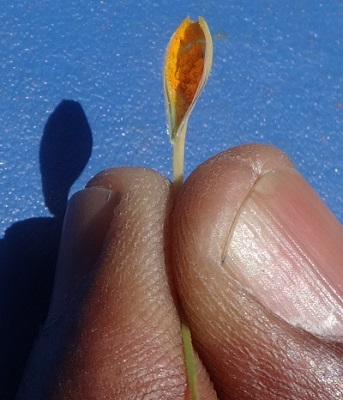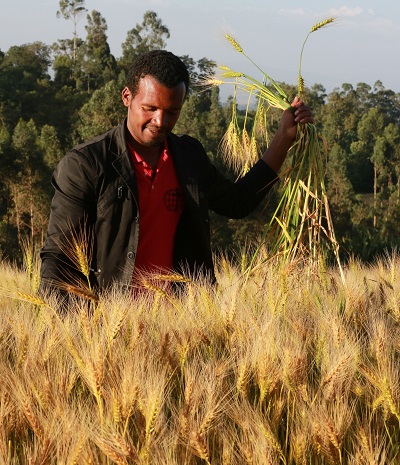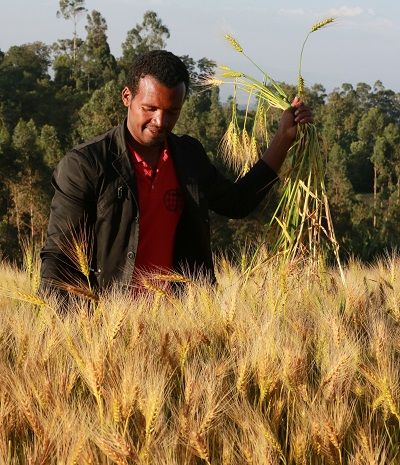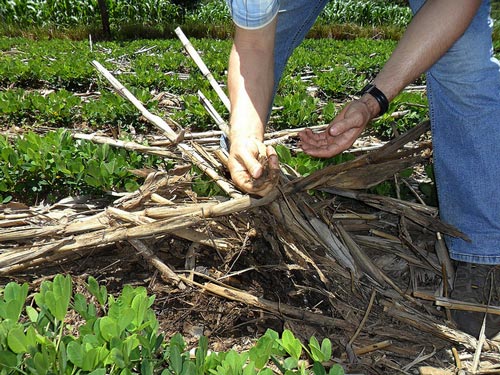Mutating diseases drive wheat variety turnover in Ethiopia, new study shows

Rapidly emerging and evolving races of wheat stem rust and stripe rust disease—the crop’s deadliest scourges worldwide—drove large-scale seed replacement by Ethiopia’s farmers during 2009-14, as the genetic resistance of widely-grown wheat varieties no longer proved effective against the novel pathogen strains, according to a new study by the International Maize and Wheat Improvement Center (CIMMYT).
Based on two surveys conducted by CIMMYT and the Ethiopian Institute of Agricultural Research (EIAR) and involving more than 2,000 Ethiopian wheat farmers, the study shows that farmers need access to a range of genetically diverse wheat varieties whose resistance is based on multiple genes.
After a severe outbreak in 2010-11 of a previously unseen stripe rust strain, 40 percent of the affected farm households quickly replaced popular but susceptible wheat varieties, according to Moti Jaleta, agricultural economist at CIMMYT and co-author of the publication.
“That epidemic hit about 600,000 hectares of wheat—30 percent of Ethiopia’s wheat lands—and farmers said it cut their yields in half,” Jaleta said. “In general, the rapid appearance and mutation of wheat rust races in Ethiopia has convinced farmers about the need to adopt newer, resistant varieties.”
The fourth most widely grown cereal after tef, maize, and sorghum, wheat in Ethiopia is produced largely by smallholder farmers under rainfed conditions. Wheat production and area under cultivation have increased significantly in the last decade and Ethiopia is among Africa’s top three wheat producers, but the country still imports on average 1.4 million tons of wheat per year to meet domestic demand.
National and international organizations such as EIAR, CIMMYT, and the International Centre for Agricultural Research in the Dry Areas (ICARDA) are working intensely to identify and incorporate new sources of disease resistance into improved wheat varieties and to support the multiplication of more seed to meet farmer demand.
New wheat varieties have provided bigger harvests and incomes for Ethiopia farmers in the last decade, but swiftly mutating and spreading disease strains are endangering wheat’s future, according to Dave Hodson, CIMMYT expert in geographic information and decision support systems, co-author of the new study.

“In addition to stripe rust, highly-virulent new races of stem rust are ruining wheat harvests in eastern Africa,” he explained. “These include the deadly Ug99 race group, which has spread beyond the region, and, more recently, the stem rust race TKTTF.”
As an example, he mentioned the case of the wheat variety Digalu, which is resistant to stripe rust and was quickly adopted by farmers after the 2010-11 epidemic. But Digalu has recently shown susceptibility to TKTTF stem rust and must now be replaced.
“In rust-prone Ethiopia, the risks of over-reliance on a widely-sown variety that is protected by a single, major resistance gene—Digalu, for example—are clearly apparent,” he added. “CIMMYT and partners are working hard to replace it with a new variety whose resistance is genetically more complex and durable.”
Hodson said as well that continuous monitoring of the rust populations in Ethiopia and the surrounding region is essential to detect and respond to emerging threats, as well as to ensure that the key pathogen races are used to screen for resistance in wheat breeding programs.
Hodson and partners at the John Innes Centre, UK, and EIAR are leading development of a handheld tool that allows rapid identification of disease strains in the field, instead of having to send them to a laboratory and lose precious time awaiting the results.
CIMMYT and partners are also applying molecular tools to study wheat varietal use in Ethiopia. “There are indications that yields reported by farmers were much lower than official statistics, and farmer recollections of varietal names and other information are not always exact,” Hodson explained. “We are analyzing results now of a follow-up study that uses DNA fingerprinting to better document varietal use and turnover.”
The authors would like to acknowledge the Standing Panel for Impact Assessment (SPIA) for financing, the Diffusion and Impacts of Improved Varieties in Africa (DIIVA) project that supported the first survey in 2011, and Cornell University, the Bill & Melinda Gates Foundation, and United Kingdom’s Department for International Development (DFID) through the Durable Rust Resistance in Wheat (DRRW, now called Delivering Genetic Gain in Wheat) project for support for the second survey in 2014.

 After months of discussions and debates on the scientific evidence regarding conservation agriculture for small-scale, resource-poor farmers in Sub-Saharan Africa and South Asia, a group of 40 scientists reached a consensus on the goals of conservation agriculture and the research necessary to reach these goals. The discussions leading to the signing of the
After months of discussions and debates on the scientific evidence regarding conservation agriculture for small-scale, resource-poor farmers in Sub-Saharan Africa and South Asia, a group of 40 scientists reached a consensus on the goals of conservation agriculture and the research necessary to reach these goals. The discussions leading to the signing of the